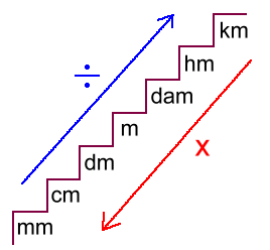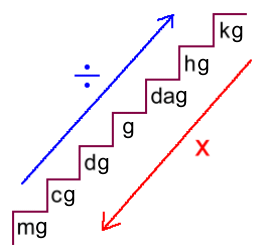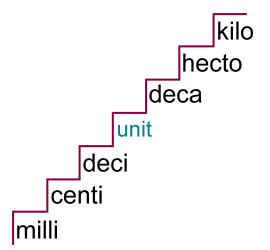 Metric units are used by almost all countries in the world. Metric units are much easier to use than Imperial units; all the conversions are multiples of ten, and the conversion method and names are the same for distance, mass, volume, and other units. For example: When measuring metric distance, the base unit is the metre. A decametre is 10 metres. A hectometre is 100 metres. A kilometre is 1000 metres. A decimetre is a tenth of a metre. A centimetre is a hundredth of a metre. A millimetre is a thousandth of a metre. Distance Units One metre is easy to visualize; we've all seen metre sticks in a classroom. A metre is made up of 100 centimetres; a centimetre is about the length of a fingernail. A centimetre is made up of 10 millimetres; a millimetre is about the width of a pencil lead. A metre must then be made up of 1000 millimetres A kilometre is made up of 1000 metres. Other divisions aren't often used; here they are: 

Conversions Conversions between units are always done the same way, and always involve multiples of ten, unlike Imperial conversions where every conversion requires a different multiplier. Here's how to convert Metric units. Distance  We'll use the simple 'staircase' method. To change a unit to a smaller unit, you move down the staircase, multiplying by a power of ten matching the number of steps. To change a unit to a larger unit, you move up the staircase, dividing by a power of ten matching the number of steps. For example: Change 35 metres to centimetres This is moving down the staircase two steps, so we multiply by 10x10, or 100 35 x 100 = 3500 cm Change 0.013 kilometres to decimetres This is moving down the staircase four steps, so we multiply by 10x10x10x10, or 10,000 0.013 x 10,000 = 130 dm Change 420 centimetres to metres This is moving up the staircase two steps, so we divide by 10x10, or 100 420 ÷ 100 = 4.2 m Change 13,500 millimetres to hectometres This is moving up the staircase five steps, so we divide by 10x10x10x10x10, or 100,000 13,500 ÷ 100,000 = 0.135 hm Mass When measuring metric mass, the base unit is the gram. A decagram is 10 grams. A hectogram is 100 grams. A kilogram is 1000 grams. A decigram is a tenth of a gram. A centigram is a hundredth of a gram. A milligram is a thousandth of a gram. One kilogram is the mass of a liter of water, or a pineapple. One gram is the mass of a raisin, or a paperclip. Let's try some mass conversions: 
Change 0.45 kilograms to grams This is moving down the staircase three steps, so we multiply by 10x10x10, or 1000 0.45 x 1000 = 450 g Change 38 milligrams to centigrams This is moving up the staircase one step, so we divide by 10 38 ÷ 10 = 3.8 cg  All fundamental unit conversions in the Metric system use the same prefixes and powers-of-ten relationship. This makes it easy to convert, even with unfamiliar units. For example, if the basic unit of power is the watt, convert 0.752 kilowatts to watts: Three steps down the staircase: 0.752 x 1000 = 752 watts |